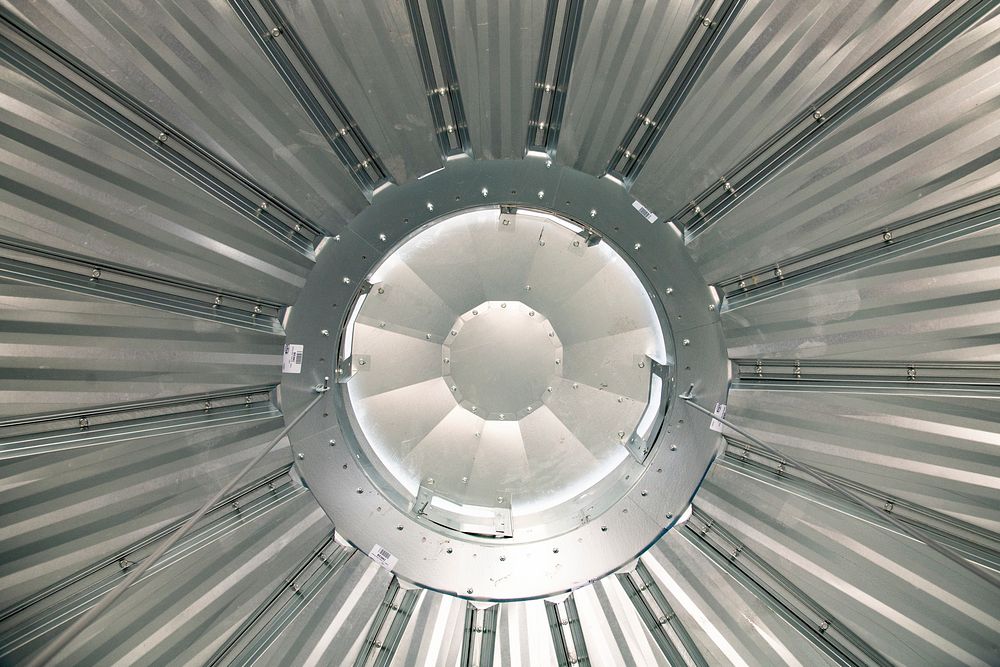https://www.usa.gov/copyrighted-government-workshttps://www.rawpixel.com/image/9653472

Designed for hot environments, the cupola vent extracts heat from interior. A double layer roof reduces heat transfer from the outside of the Sukup Safe T Home® that GoServ Global and Sukup Manufacturing Co. showcase at the Farm Progress Show in Boone, IA, on August 31, 2022. They showcase a highly modified grain bin resistant to earthquakes, termites, and moisture. Grain bin houses or silo homes have provided disaster relief to families worldwide with day-to-day shelter for those who need a safe place to live.
A devastating earthquake hit Haiti in 2010, destroying homes, businesses, and facilities. During the recovery period, their teams saw an opportunity to build cost-effective refugee housing that would withstand natural disasters.
These homes have withstood Hurricane Matthew's 145-mile-per-hour winds for the 8-hour duration with minimal damage. Since then, they have provided nearly 300 silo homes in Haiti, as well as homes in Uganda for refugee children fleeing from South Sudan, Peru, and Kenya.
A Safe T Home® costs $5,700 for nonprofits intending to use the grain bin house for humanitarian efforts. Approximately ten homes fit on one shipping container. Other installation costs for shipping and building of cement foundation can bring the prices to roughly $7,500 for one of these homes.
The overall round design withstands high winds, while the near-zero seismic load is virtually earthquake-proof. Inside, 254 sq. ft. provides families with long-term refugee housing or short-term disaster relief.
These homes made of 20-gauge galvanized steel have a 75-year life expectancy. These silo homes measure 18 ft. in diameter with eight ft. sidewalls. They stand 13.5 ft. from the bottom to the roof peak.
The double roof system deflects heat, redirects rainwater, and ventilates the interior space regardless of wind direction. The roof can support 5,000 pounds for families who wish to add a sleeping or storage loft. Outside, three container spaces for cement and other heavy material provide up to 18,000 pounds of ballast to weigh the structure down against wind or waves. Window gardens can grow on the ballast material.
The galvanized building material provides 100 percent termite, fire, and weatherproof. The metal windows have lockable covers for security and 16-gauge, galvanized steel screens. Each home includes a solar panel, giving families renewable energy for lighting.
Homes also have water collection potential. Louvers in the heat shield capture rainwater for cooking, bathing, or growing crops.
GoServ Global is a nonprofit organization.
The Farm Progress Show allows visitors to see the latest equipment and more in Boone IA, on August 31, 2022.
National and international farmers and ranchers can see agriculture’s latest product introductions, meet face-to-face with agribusiness professionals, and gain hands-on knowledge. On hand are educational and U.S. Department of Agriculture USDA agencies such as the National Agricultural Statistics Service NASS, Risk Management Agency RMA, Farm Services Agency FSA, and Natural Resources Conservation Service NRCS.
For more information about these organizations, go to:
nass.usda.gov
rma.usda.gov
fsa.usda.gov
nrcs.usda.gov
USDA Media by Lance Cheung.
Original public domain image from Flickr
Public DomainFree CCO U.S. Government image for Personal and Business use